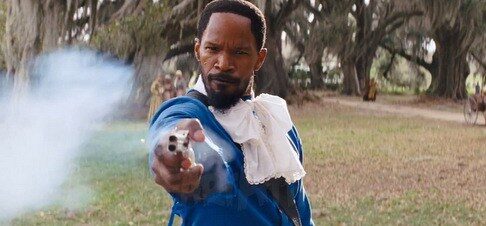Review: Django Unchained

Starring: Jamie Foxx, Christoph Waltz, Leonardo DiCaprio
Directed By: Quentin Tarantino
MILD SPOILERS
A Quentin Tarantino movie cannot be summed up by genre. It transcends, using in this case ‘the Western’ to unfold a cruel, but humorous tale of robust men and women defined by the myth of the Old West. Case in point: Django Unchained is actually set in the Deep South. Each character we encounter is playing a role; constructing a persona comprised of violent gambits and double-talk. Sharen Davis’ costume design quietly reveals their intentions so we know these individuals before they know themselves.
Slave Django (Jamie Foxx) may be unchained in the first scene, but he does not become Django the man until the last. He is initiated as a killer by bounty hunter Dr. King Schultz (Christoph Waltz), a slight man in expensive clothes; tweed, an Inverness (actually cotton), even a chinchilla coat (faux), who used to practise dentistry before he turned to the gun. In one of the film’s most amusing moments, after giving Django freedom Schultz offers to buy him a new suit – whatever he chooses. Django selects a blue two piece with lace cravat and knickerbockers, because after years in rags this is what he assumes a gentleman, or in this instance a gentleman’s valet would wear. It is tempting to laugh because he ‘got it wrong’, but this is not true. At this juncture in the story Django does not know who he is; being mocked for wearing a preposterous suit is part of his self-discovery.

Django Unchained is set in 1859, two years before America’s Civil War. The exact year is important because clothing styles changed so much during that period that costume designer Sharen Davis had to narrow the film down to one interpretable look. Fabrics on display include duck, cotton, canvas, fur and leather..
Django’s amusing valet attire disarms his enemies without even cocking a hammer. Of course when Django does open fire it is clear to Schultz that he shows potential for his (law abiding) bounty hunting profession, or to “Kill white folks and they pay you for it”. Now Django adopts what will become his uniform: a flat crown, sharply upturned brim hat with studded band and short green corduroy jacket belonging to decent singing cowboy ‘Little Joe’ from TV series Bonanza. This jacket means the same to Django as Clint Eastwood’s poncho in the Sergio Leone Spaghetti Westerns. Without it he is playing a role; with it he is Django: bounty hunter, killer and hero – it ascribes his personality. Were Quentin Tarantino to make a follow up to Django Unchained, and his screenplay is surely written with that in mind, he would be crazy to ditch this costume. Django needs his green jacket and hat just as Superman needs his cape.
All the central characters can be interpreted by what they wear. Broomhilda Von Shaft (Kerry Washington) is like most women without means during the pre-Civil War period, dressed in workwear. Of course Broomhilda is a slave, but that does not necessarily imply her garments are rags. Workwear in this instance equates to a traditional maid’s uniform, or ‘in house’ (i.e. entertaining) attire. Likewise the Southern Belle dresses seen on courtesans at Kentucky Fried ‘Big Daddy’ Bennet’s (Don Johnson) ranch. These women are dressed to serve men, and as with her husband Django, Broomhilda’s true appearance is only revealed at the end of the story. Even flamboyant plantation owner Calvin Candie (Leonardo DiCaprio) is fronting a disguise. He walks and talks a peacock, his sharply cut coats hand-in-hand with even sharper retorts. But unlike his acute prospect Dr. King Schultz, Candie is physically and mentally impotent. He tempts fate yet fails to react when it obliges. Django chooses to wear Candie’s clothes during the finale to become what he despises in order to destroy his memory.

The blue suit chosen by Django after he agrees to team up with Schultz is period accurate attire for a valet. The lace cravat is an artistic indulgence, but adds to the intentional ridiculousness of his ‘disguise’. The same goes for Django’s sunglasses; during a time when wearing any kind of eyeglasses would have been a sign of visual impairment, he wears them to look cool.
Django Unchained feels very much contemporary Quentin Tarantino. It is Inglourious Basterds rather than Pulp Fiction, and not just for Christoph Waltz again nibbling elegantly through his dialogue. The pacing will test some for sure; there are equal batches violence and conversation, though not a whipping or word is wasted. Importantly, Sharen Davis is a good fit for Tarantino; she understands that underneath all his conspicuous directorial trademarks, layered subtlety is prevalent. Django Unchained is not a revenge tale, it’s an origin story. Tarantino cannot waste this character; he must make a sequel.
Django Unchained was released in the U.S on 25th December and will be released in the UK on 18th January.
© 2012 – 2014, Lord Christopher Laverty.